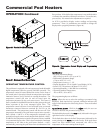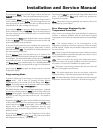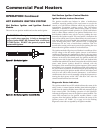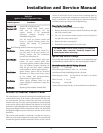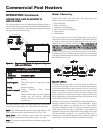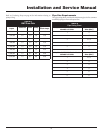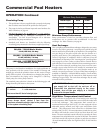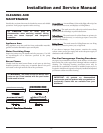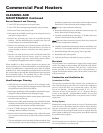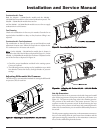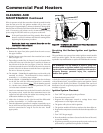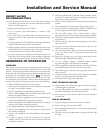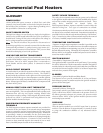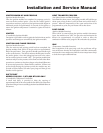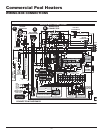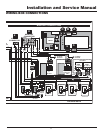
Commercial Pool Heaters
CLEANING AND
MAINTENANCE Continued
Burner Removal and Cleaning
1. Turn “OFF” the main power to the pool heater.
2. Turn “OFF” the main manual gas shutoff to the pool heater.
3. Remove the front outer jacket panels.
4. Disconnect the manifold from the gas train using the union(s)
just below each gas valve(s).
5. Remove the mounting nuts from the manifold mounting
brackets. Pull the manifold/orifice assembly away from the
burners. Repeat for each manifold assembly.
6. Remove two mounting screws from the burner and slide the
burner out toward the front of the pool heater. Use caution to
prevent damage to burners, refractory, hot surface igniter or
wiring.
7. Remove soot from the burners with a stiff bristle brush. Dirt
may be removed from the burner ports by rinsing the
burner thoroughly with water. Drain and dry burners before
re-installing. Damaged burners must be replaced.
When installed in a dusty and dirty location, the burners may
require cleaning on a 3 to 6 month schedule or as needed, based on
severity of contamination. Contaminants can be drawn in with the
combustion air. Non-combustible particulate matter such as dust,
dirt, concrete dust or dry wall dust can block burner ports and cause
non-warrantable failure. The standard inlet air filter will help
eliminate dust and dirt from entering the pool heater.
Heat Exchanger Cleaning
1. While burners are removed, check the heat exchanger surface
for sooting. If present, the heat exchanger must be cleaned and
the problem corrected. Proceed as follows.
2. Remove gas manifold(s)/orifice assemblies as described in steps 1
through 5 in Burner Removal and Cleaning, this page.
3. Disconnect the wiring from the hot surface igniter and the hoses
from the burner pressure tap.
4. Remove inner jacket panel mounting screws and slide the door
assembly out toward the front of the pool heater. Use caution to
prevent damage to the refractory and hot surface igniter.
5. Check “V” baffles along the front and back edges of the heat
exchanger. Remove and clean if necessary.
6. Remove soot from the heat exchanger with a stiff bristle brush.
Use a vacuum to remove loose soot from the surfaces and inner
chamber.
7. The heat exchanger can be removed by sliding towards the front
of the pool heater. Once the heat exchanger is removed from the
pool heater, a garden hose can be used to wash the tubes to ensure
that all soot is removed from the heat exchanger surfaces.
Note:
Do not wet the pool heater’s refractory.
8. Ensure that all burner ports are cleaned to remove any soot. See
Burner Removal and Cleaning, this page.
9. Carefully reinstall the heat exchanger, “V” baffles, and frame
runners if removed from the pool heater.
Note:
Make sure frame runners seal securely where they contact the
front and rear compartment refractory.
10. Carefully reinstall inner jacket panels, burners, manifolds, wires
and hoses. Use new gasket material to ensure a proper air seal.
11. Reassemble all gas and water piping. Test for gas leaks.
12. Reassemble outer jacket panels.
13. Cycle the pool heater and check for proper operation.
Electrical
This pool heater uses a transformer to supply a low voltage control
circuit. The voltage on the secondary side should be 24 to 28VAC
when measured with a voltmeter. This unit has a 7 AMP circuit
breaker provided on the secondary side of the transformer. A
tripped circuit breaker indicates a short in the 24VAC controls that
must be corrected.
Combustion and Ventilation Air
Combustion Air Filter
This unit has a standard air filter located at the combustion air
inlet. This filter helps ensure clean air is used for the combustion
process. Check this filter every month and replace. The filter
size on the 500,000 - 750,000 Btu/hr models is 12" x 12" x 1"
(30.5cm x 30.5cm x 2.5cm) and 16" x 16" x 1" (40.6cm x 40.6cm x
2.5cm) on the 990,000 - 2,070,000 Btu/hr models. You can find
these commercially available filters at any home center or HVAC
supply store.
Venting System
Examine the venting system at least once a year. Check more often
in the first year to determine inspection interval. Check all joints
and pipe connections for tightness, corrosion or deterioration.
Clean screens in the venting air intake system as required. Have the
entire system, including the venting system, periodically inspected
by a qualified service agency.
Air Flow
Check frequently to be sure the flow of combustion and ventilation
air to the pool heater is not obstructed.
48



